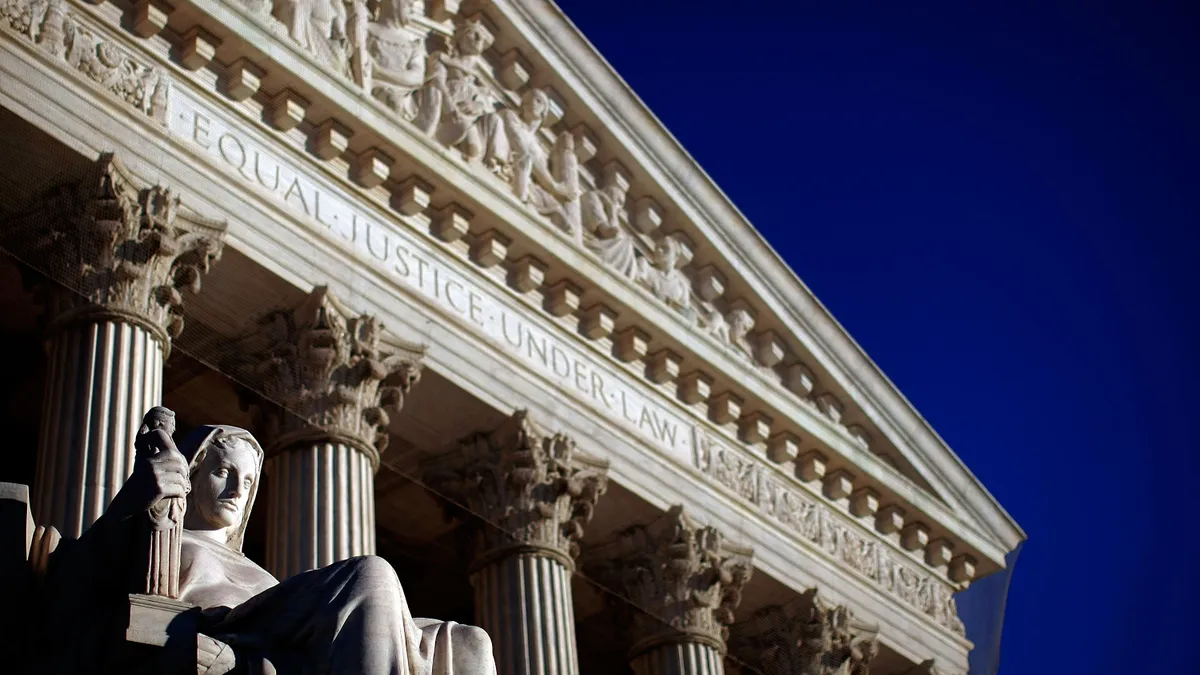Dive Brief:
-
The Supreme Court's decision to review a lower court's ruling striking down Trump administration regulations governing greenhouse gas (GHG) emissions from power plants could limit the Environmental Protection Agency's options for regulating the power sector, according to legal observers.
-
The high court on Friday agreed to review a January decision by the U.S. Court of Appeals for the District of Columbia Circuit to vacate the Affordable Clean Energy (ACE) rule, which the Trump administration used to replace the more stringent Clean Power Plan adopted during the Obama administration.
-
With a decision expected early next summer, the Supreme Court could prevent the EPA from regulating GHG emissions across broad generating fleets as the Obama rule tried to do and instead require it be done on a power plant-by-power plant basis, legal experts said.
Dive Insight:
The Supreme Court's decision to consider four consolidated appeals could hamper the Biden administration's goal of cutting U.S. GHG emissions by up to 52% below 2005 levels by the end of this decade.
It comes as the EPA is developing a new plan for cutting emissions from the power sector, the second leading source of carbon emissions behind transportation.
In its appeal of the January appeals court decision, a group of states, led by West Virginia, argued the court took too broad a view of the EPA's authority under the Clean Air Act.
The dispute centers on the Clean Air Act's section 111(d), which the Obama administration used as the basis for setting fleet-wide emissions reduction requirements under the Clean Power Plan. The states contend the section cannot be used to establish fleet-wide emissions targets.
It is "very unusual" for the Supreme Court to review cases when the government is writing a regulation that is at the center of the case, Michael Gerrard, director of the Sabin Center for Climate Change Law at Columbia Law School, said Monday, noting the court broke precedent when it stayed the Clean Power Plan while it was being reviewed by an appeals court.
"It's not a good omen for EPA's position," Gerrard said.
Possible outcomes include a ruling that the EPA cannot use section 111(d) as contemplated under the Clean Power Plan or the court could invoke the "major questions" doctrine and find that the section is too vague and Congress needed to be more explicit in the authority the section gave the EPA, according to Gerrard.
Also, several Supreme Court judges have indicated they are open to reviving the "non-delegation" doctrine, which centers on how much decision-making authority federal agencies have, Gerrard said. The doctrine has only been used twice by the court, both times in 1935, to strike down federal regulations, he said.
"There are not a lot of good outcomes for the Biden EPA," said Patrick Traylor, a partner at Vinson & Elkins and former deputy assistant administrator for the EPA's Office of Enforcement and Compliance Assurance during the Trump administration.
The Supreme Court has shown it is "deeply skeptical" of the Clean Power Plan and its scope, according to Traylor.
While the case is focused on section 111(d), a Supreme Court ruling could clarify limits to an agency's authority to apply statutes in ways Congress didn't contemplate, Traylor said.
At least four Supreme Court judges agreed to consider the Clean Air Act case, Traylor noted.
"With this court, and the kind of six-three split, maybe five-four split depending on how Chief Justice Roberts goes, on these questions of separation of powers, I have a really hard time thinking that this is going to go well for the Biden EPA," Traylor said.
A court ruling limiting the use of section 111(d) would "take one important tool of the tool box" the EPA can use to regulate GHG emissions from the power sector, according to Gerrard.
"EPA would presumably be limited to setting GHG emissions standards for power plants based only on what technologies can be applied directly to high-emitting plants," Jeff Dennis, Advanced Energy Economy managing director and general counsel, said Monday on Twitter.
The Supreme Court's review of the EPA's authority to set limits on GHG emissions is part of a decade-long legal back-and-forth, according to Megan Houdeshel, a partner with Dorsey & Whitney who co-chairs the firm's Energy & Natural Resources Industry Group.
"This regulatory whiplash could come to an end if the Supreme Court determines EPA does not have the authority to impose more stringent greenhouse gas regulations on power plants, and would deal a blow to the Biden administration's climate change agenda," Houdeshel said Monday in a statement.
The Supreme Court will likely hold oral arguments in the spring and issue a decision in May or June, according to Gerrard.














